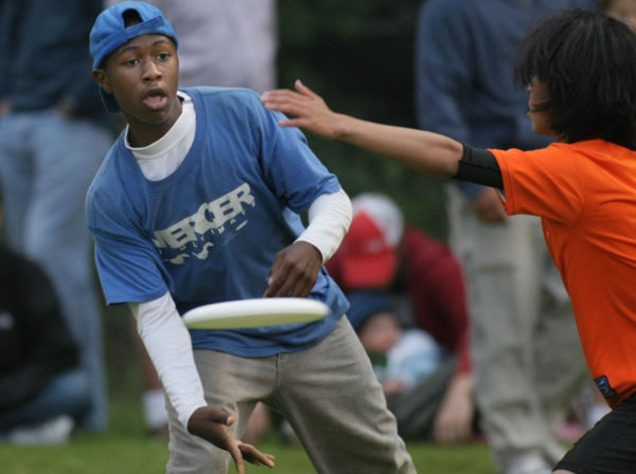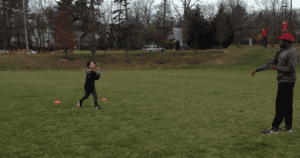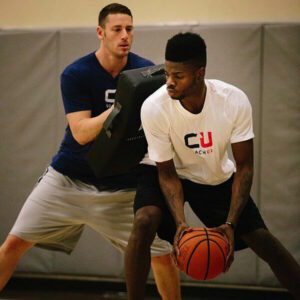For inexperienced teams, the zone defense can be absolute kryptonite to any previously well-adjusted plan. The zone defense focuses on achieving a laundry list of things, but disrupting the game’s flow and attempting to pile extra pressure on the Handlers may just top it. In fact, this type of of defense typically thrives upon forcing poor Handlers into even poorer decisions. Although there are plenty of nuances and subtle changes, we’re going to focus on the most popular formation, the 3-3-1. So, if your team has started running a zone on defense and you’re not quite sure where you fit in, consider the notes, details, and tips below. The 3-3-1 zone is a personal favorite at CoachUp, so we could not suggest it higher for those that are looking to confuse and frustrate their opponents.

3-3-1
The 3-3-1 is a staple of Ultimate as we know it and if you’re planning on playing at another level, it’s important to find your niche in this delicate system. This formation works wonderfully if any number of these factors are in play, they are: bad weather, bad Handlers, or hard-working defenders. Ultimately, the very best athletes excel at the majority of positions in the 3-3-1, but for beginners, it’s best to figure out just which spot is worth mastering early on. Of course, as the name suggests, we have three zones, one made up of three players in the front, one with three patrolling the middle of the field, and the final zone cleaning up any deep huck attempts. Here’s a general guide to the positions, locations, and overall goals — what will you choose?
The Cup
On first thought, the cup might even seem fun, heck it might even seem easy. Take it from us, however, and understand that playing in the cup can be one of the most demanding efforts in Ultimate. This cup breaks down into three smaller roles that must work or the entire defensive formation will fall apart in an instant. Athletes who take on the challenge of the cup need to be disciplined, communicative, and undeniably hard-working. All it takes is one fast swing to leave the whole team trying to desperately chasing.
Every successful cup will have one of the three defenders specifically marking the disc thrower and he or she will force them towards the middle. It is of the highest importance that the player forcing middle does not get broken. So if the player is forcing on the thrower’s right side and towards the middle, they must, at all costs, not allow a pass to the Handler on the right. The other two positions in the cup must be ten feet away, in order to avoid an illegal double team, but they’ll help to form a semi-circle.
That way, the Handler, as he is forced towards the defenders and cup in front of him, is presented with a difficult decision. At best, the cup will force the Handler into an ill-advised throw downfield that your Mids or Deep can swallow up. On the other hand, your cup should, at the very least, keep the offense swinging the disc laterally instead of getting yardage downfield. All three players in the cup should be an adapt point defender, but also posses the ability to athletically make plays in the semi-circle. Players in the cup must be sure not to make risky plays on the disc as it will likely lead to a broken defense in actuality. Remember that the goal of the cup isn’t to intercept or deflect the passes themselves, although those type of results are always welcomed, instead, these defenders are working hard to force those less-than-ideal throws for their teammates downfield to snag. So, don’t be frustrated when the Handlers just swing it back and forth, that means your cup and overall defense is working.
However, here’s where it gets a bit tricky: when the disc is swung, the cup must move in symphony in order to keep the defensive pressure going. This may also include the changing of the point defender, so make sure that you and your teammates are communicating clearly. Again, the force should push the opposing team back towards the middle, so keep that in mind while defending the disc. If one player is exhausted and far behind the cup, the entire thing will fall apart. Either the handler will have a large gap through the middle to exploit or he’ll have no stall count pressure to deal with, both are undesirable. These three players will chase the disc around the field from Handler to Handler for the entire point.
In some, but not all cases, your athletes in the cup will be the team’s Handlers — that way, after a turnover, they can initiate immediate offense going the other way.
The Mids
Now, the Mids will be in your typical zone set-up with each defending one third of the field. It’s important to realize that players in the middle are not man guarding specific athletes, just those that flash into their zone. Additionally, they must not get sucked too far in or too far out as well — this, obviously, will be at the discretion of the athlete, but it’s unhelpful to leave such a large part of your third open if you follow a popper up to the cup. At that point, it’s better just to let the cup handle it and get back to observing passes with longer potential gain on them. Remember, the zone defense, especially the 3-3-1 formations, only work if the sum of all parts are equal. This means being smart and decisive, but also sharp, athletic, and agile under pressure.
If an opposing player catches a pass in your zone, the first inclination would be to immediately drop back, wait for the cup, and reset the zone; and, in most cases, this is a great plan, all things considered. However, if you’ve followed a cut in and your mark catches the disc with your cup still a bit away, feel free to provide pressure. Although just momentarily, it will stop any easy fast break opportunities and quell any more large yard gains. Then, once your cup arrives, step back into your regular positioning and resume your responsibilities. Additionally. be sure to communicate with your fellow Mids and Deep in order to make sure that all opposing players are accounted for. If the Deep is focused on the left side of the field and a player leaves your zone on a deep cut to the right, it’s your responsibility to make sure your teammate is aware.
The Deep
Now, allow us to make a comparison with couple sports — soccer’s goaltender and football’s safety — in order to fully grasp the constantly evolving responsibilities of the 3-3-1 zone’s Deep. In soccer, you need a loud, out-going, and vocal leader, somebody that has a keen eye for detail and even more willing to correct their teammates. Like a keeper, the Deep must be willing to analyze the game in front of them and alert their defenders of in-cuts and potential pitfalls. If your team is getting beaten continuously by a certain player or popper’s cut, it’s the Deep’s responsibility to let them know when and where they’re coming from or any other necessary adjustments.
Furthermore, it’s your Deep’s responsibility to react and deny any long throws and hucks, which is where the safety playing skills come into play. This player needs to be an absolute hawk with the ability to run, jump, dive, and do anything in their power to stop any deep throws and their completion. These players are often left out on an island and can only rely on their instincts, abilities, and reaction time in order to save a point. On top of all that, it’s incredibly helpful to be able to read the game as it’s happening and quickly analyze what might happen next. For example, if they can see the disc swinging and a player making a cross-field cut towards that potentially new space, it’s a safe bet that you will be called upon to defend. Thus, if you’re able to read the game one or two steps ahead, you’ll have a better jump later on.
(Related: Read about respecting Spirit of the Game here.)
Huddle Up Additionally, there are plenty of alterations to the zone defense — like the 1-3-3, which flips the 3-3-1 on its head and asks one player to chase the disc around while the other two groups of three act as pivoting, mirroring, and impenetrable walls — but it’s the 3-3-1 that will be utilized most frequently, especially for teams with lower levels of experience. Zone defenses offer teams the ability to learn and grow as a single, fluid unit. The problem with man-to-man is that each player can only rely on themselves to create pressure, turnovers, and overall trouble for the opposing team. However, the zones force the team to evolve together — if your cup is slow or unimaginative, you’ll get burned. If your Mids aren’t communicating with each other effectively, poppers will undoubtedly hack their way into open space. Teams are only as strong as their weakest link and the zone goes a far way towards creating an environment where each player is as important as the rest.
So, whether you’re in the cup or commanding people from the back as a Deep, find your niche and excel at it. If you’re still struggling to understand your role in the zone, consider booking one of CoachUp’s private trainers to guide you in the right direction. Our established, veteran team will have you revolutionizing the field and making an undeniable difference in no time — what are you waiting for?
(Thanks to Major League Ultimate for the gif!)
Be prepared for the biggest moments by mastering the small ones off the field.
How useful was this post?
Click on a star to rate it!
Average rating 5 / 5. Vote count: 3
No votes so far! Be the first to rate this post.



